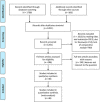Comparison of 3 Minimally Invasive Methods Versus Open Distal Pancreatectomy: A Systematic Review and Network Meta-Analysis
- PMID: 32890249
- PMCID: PMC8096312
- DOI: 10.1097/SLE.0000000000000846
Comparison of 3 Minimally Invasive Methods Versus Open Distal Pancreatectomy: A Systematic Review and Network Meta-Analysis
Abstract
Background: The efficacy and safety of open distal pancreatectomy (DP), laparoscopic DP, robot-assisted laparoscopic DP, and robotic DP have not been established. The authors aimed to comprehensively compare these 4 surgical methods using a network meta-analysis.
Materials and methods: The authors systematically searched MEDLINE, Scopus, Web of Science, the Cochrane Central Register of Controlled Trials, and ClinicalTrials.gov for studies that evaluated at least 2 of the following pancreatectomy techniques: robot-assisted DP, laparoscopic DP, open DP, and robotic DP. The surface under the cumulative ranking curve (SUCRA) was applied to show the probability that each method would be the best for each outcome.
Results: Altogether, 46 trials with 8377 patients were included in this network meta-analysis. Robotic DP showed the highest probability of having the least estimated blood loss (SUCRA, 90.9%), the lowest incidences of postoperative pancreatic fistula (SUCRA, 94.5%), clinically related postoperative pancreatic fistula (SUCRA, 94.6%), postoperative bleeding (SUCRA, 75.3%), reoperation (SUCRA, 96.4%), overall complications (SUCRA, 86.9%), and major complications (SUCRA, 99.3%), and the lowest mortality (SUCRA, 83.4%). Robotic DP also proved to be the best approach regarding the attainment of R0 resection (SUCRA, 75.4%) and the number of lymph nodes harvested (SUCRA, 64.1%).
Conclusion: Robotic DP seems to offer clinical and oncological advantages compared with other DP methods for addressing diseases of the pancreatic body and tail, although it may require a longer operation time and learning curve. The present results require confirmation in future head-to-head randomized controlled trials.
Copyright © 2020 The Author(s). Published by Wolters Kluwer Health, Inc.
Conflict of interest statement
The author declares no conflicts of interest.
Figures


Similar articles
-
Systemic pharmacological treatments for chronic plaque psoriasis: a network meta-analysis.Cochrane Database Syst Rev. 2021 Apr 19;4(4):CD011535. doi: 10.1002/14651858.CD011535.pub4. Cochrane Database Syst Rev. 2021. Update in: Cochrane Database Syst Rev. 2022 May 23;5:CD011535. doi: 10.1002/14651858.CD011535.pub5. PMID: 33871055 Free PMC article. Updated.
-
Learning curve of laparoscopic and robotic pancreas resections: a systematic review.Surgery. 2021 Jul;170(1):194-206. doi: 10.1016/j.surg.2020.11.046. Epub 2021 Feb 2. Surgery. 2021. PMID: 33541746
-
Minimally invasive versus open central pancreatectomy: Systematic review and meta-analysis.Surgery. 2022 Nov;172(5):1490-1501. doi: 10.1016/j.surg.2022.06.024. Epub 2022 Aug 18. Surgery. 2022. PMID: 35987787
-
International validation of the distal pancreatectomy fistula risk score: evaluation in minimally invasive and open surgery.Surg Endosc. 2025 Aug;39(8):4863-4871. doi: 10.1007/s00464-025-11872-5. Epub 2025 Jun 20. Surg Endosc. 2025. PMID: 40542140 Free PMC article.
-
Systematic review and meta-analysis of robotic versus laparoscopic distal pancreatectomy for benign and malignant pancreatic lesions.Surg Endosc. 2016 Sep;30(9):4078-85. doi: 10.1007/s00464-015-4723-7. Epub 2016 Jan 7. Surg Endosc. 2016. PMID: 26743110
Cited by
-
Robotic Versus Hand-Assisted Distal Pancreatectomy: A Comparative Single Center Retrospective Study.J Clin Med. 2025 Jul 11;14(14):4919. doi: 10.3390/jcm14144919. J Clin Med. 2025. PMID: 40725612 Free PMC article.
-
Short-Term Outcomes of Conventional Laparoscopic versus Robot-Assisted Distal Pancreatectomy for Malignancy: Evidence from US National Inpatient Sample, 2005-2018.Cancers (Basel). 2024 Feb 29;16(5):1003. doi: 10.3390/cancers16051003. Cancers (Basel). 2024. PMID: 38473361 Free PMC article.
-
The Brescia Internationally Validated European Guidelines on Minimally Invasive Pancreatic Surgery (EGUMIPS).Ann Surg. 2024 Jan 1;279(1):45-57. doi: 10.1097/SLA.0000000000006006. Epub 2023 Jul 14. Ann Surg. 2024. PMID: 37450702 Free PMC article.
-
Study International Multicentric Pancreatic Left Resections (SIMPLR): Does Surgical Approach Matter?Cancers (Basel). 2024 Mar 5;16(5):1051. doi: 10.3390/cancers16051051. Cancers (Basel). 2024. PMID: 38473411 Free PMC article.
-
International consensus guidelines on robotic pancreatic surgery in 2023.Hepatobiliary Surg Nutr. 2024 Feb 1;13(1):89-104. doi: 10.21037/hbsn-23-132. Epub 2024 Jan 18. Hepatobiliary Surg Nutr. 2024. PMID: 38322212 Free PMC article. Review.
References
-
- Asbun HJ, Stauffer JA. Laparoscopic vs open pancreaticoduodenectomy: overall outcomes and severity of complications using the Accordion Severity Grading System. J Am Coll Surg. 2012;215:810–819. - PubMed
-
- Chalikonda S, Aguilar-Saavedra JR, Walsh RM. Laparoscopic robotic-assisted pancreaticoduodenectomy: a case-matched comparison with open resection. Surg Endosc. 2012;26:2397–2402. - PubMed
-
- Giulianotti PC, Sbrana F, Bianco FM, et al. . Robot-assisted laparoscopic pancreatic surgery: single-surgeon experience. Surg Endosc. 2010;24:1646–1657. - PubMed
-
- Zureikat AH, Postlewait LM, Liu Y, et al. . A multi-institutional comparison of perioperative outcomes of robotic and open pancreaticoduodenectomy. Ann Surg. 2016;264:640–649. - PubMed
-
- Asbun HJ, Moekotte AL, Vissers FL, et al. . The Miami International Evidence-based Guidelines on minimally invasive pancreas resection. Ann Surg. 2020;271:1–14. - PubMed
Publication types
MeSH terms
LinkOut - more resources
Full Text Sources
Medical

